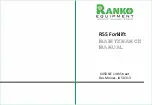
60
Chapter three
Operation,use and safety for forklift
Ⅰ、
Driving and operation
There are some information for operating normally as below and it favor you about good
running performance, using safely, running economically.
1. Usage of new vehicle
·All of the parking parts from the new vehicle should be reclaimed according to the
establishment of local government.
·In order to insure the new vehicle can work normally, Make a trial run of it before use
it.
The life-span of vehicle depends on how you begin to use your new forklift. At initial 200 hours
running, please to notice as follow.
·Whatever season, you have to run machine warmly before operating.
·Do maintenance better in normally.
·Do not abuse machine and unreason using.
2. Connection between load and stability
Under load curve, forklift take front wheel for pivot to keep balance of vehicle and load on fork,
please pay attention to load centre and load capacity to keep vehicle stable.
· If exceed load curve, rear wheel should be uplifted and be in danger, forklift
should be overturned to lead severe injury. Saying as below figure, load close to fork prong
is the same effect as increase weight. As in such condition, load shall be decrease.
3. Load center and load curve
Load centre means the distance between front end surface of fork and cargo cg. Said figure
of load curve show you relation of 2t forklift load centre and permitted load. figure of load curve is
adhibited on vehicle, if figure damaged, to renew it in time.
·If forklift is equipped disposal accessaries such as side-move device, scraper
bucket or rotating fork, its permited load is less than normal truck(no any accessaries), the
reason as follow:
(1) Subtract load from rated load, its weight equal to weight of accessaries.
(2)
由
Because accessaries length lead load centre to move forward, rated load is also
decrease.
Accessaries equipped lead load centre moving forward, this phenomena is called
“Load centre loss”.
Do not load exceeding the rated load shown by figure of load curve pasted on vehicle
or accessaries.
4. Forklift stability
There are regulations in ISO or other standard about forklift stability, but said regulation is not
applicable for all of running condition, forklift stability vary on different running condition.
Maximum stability is assured under below condition:
(1) Level and firm ground.
(2) Running under standard load or unloaded condition.
Standard no-load state: Fork or other bearing accessaries lie 30cm upto
ground,tilting mast backward enough without load.
Standard load condition:Fork or other loading accessaries lift up about
30cm from ground,rated load on standard load centre, mast tilting backward
to max.angle.
·When loading,keep min.tilting angle forward or backward as
can as possible, do not tilting forward unless load fixed on load






































